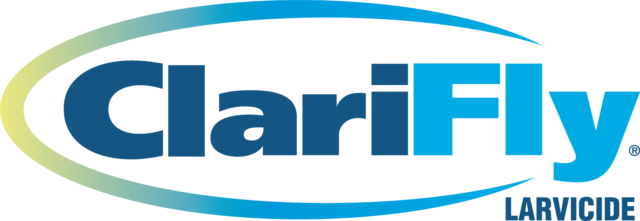Each December, Progressive Dairyman compiles a list of the most popular online content based on Google Analytics.
This list reflects content published from Oct. 1, 2014 through Oct. 1, 2015.
1. Dairywoman’s favorite cow becomes her bridesmaid
Published: July 31, 2015 e-newsletter
Summary: Talk about a crowd-pleaser! This article easily topped our list with more than 36,000 views. Student freelance writer Callie Curley featured Caroline Conley Buckingham and her unorthodox decision to include her favorite cow as a bridesmaid in her June 2015 wedding.
When we shared this story to our Facebook page, several people commented with their own stories of including their favorite cow in their wedding photos. (Though some wished they also had thought to put them in the ceremony.) Did you hear similar comments from friends in the dairy industry about their experiences of including their favorite cow on their wedding day? If so, what was one of your favorite stories?
I loved reading all the stories about other people’s favorite cows. I had always seen pictures with other cows in weddings but never actually a part of the ceremony, so that’s when I thought, “Well, why can’t she just be in the wedding?” I loved reading the comments from people who stated they wanted to include their cow when they got married. It made me feel like I inspired others that the cow can easily be a part of the bridal party. I hope people realize that cows are just like people and mean a lot to their owners. She is a part of me, and to me it meant a lot for me to have her there, so no matter what anyone said, I knew that’s what I should do. It was the best decision I’ve ever made, too!
—Caroline Conley Buckingham
After the article ran, Caroline sent us this photo of her favorite cow, Roxie, with the rest of her bridesmaids. 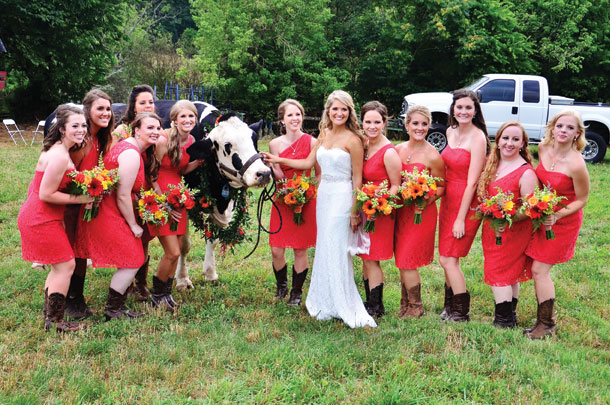
Photo courtesy Caroline Conley Buckingham.
2. Calf housing: Automatic group feeders vs. individual pens
Published: May 25, 2015 print issue
Summary: Though the outdoor individual hutch is considered the “gold standard” for young calves, there is growing interest in nursery barns that protect workers from the elements and streamline tasks for efficiency. When building or remodeling a barn for nursing calves, there are two main options: group pens with automated feeding or individual pens. Both systems can work well, and each has their pros and cons, as described by Courtney Halbach and Dr. Becky Brotzman from the Dairyland Initiative. 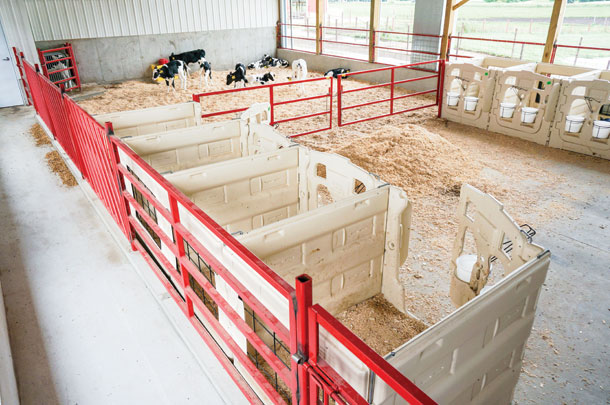
When considering group versus individual housing, what would you say are the greatest advantages of each? And what are the greatest disadvantages?
Group housing allows for a more natural feeding frequency and distribution of a greater total volume of milk or replacer throughout the day, as well as increased socialization between calves. However, limited space (less than 35 square feet per animal) and inadequate monitoring of machines and calves can increase the spread of disease.
The social benefit of group housing can be achieved through pair raising with individual pens. Simply remove a solid panel between two pens and replace with either a mesh panel or leave it completely open. Although individual pens may allow for easier disease screening, labor is primarily dedicated to feeding and cleaning up after each calf rather than monitoring and managing calf health and performance on a more flexible schedule as often found in group housing.
Plentiful space with clean, dry bedding and excellent ventilation, preferably achieved through good natural ventilation barn design, are key facility factors for successful calf barns.
—Courtney Halbach and Dr. Becky Brotzman, Dairyland Initiative
3. Finding a home to dairy: Netherlands couple settles in Indiana
Published: June 5, 2015 e-newsletter and Sept. 12, 2015 print issue
Summary: Progressive Dairyman readers loved meeting Henk and Linda Sevenhuysen through this article written by freelancer Kimmi Devaney. The Sevenhuysens started dairying in the Netherlands, moved to Canada to continue the dream and eventually settled in Indiana so they could grow their herd. Today, they’re milking 2,150 cows and raising two teenagers. 
What are some of your goals for your operation in 2016?
We don’t have much to tell you about upcoming plans ... we are more people who take the challenges as they come. Our plans for 2016: Milk cows, plant and harvest crops and stay healthy. If we achieve that, we all will be happy.
—Henk and Linda Sevenhuysen, Seven Hills Dairy
4. Capturing love on a dairy farm, one photo at a time
Published: Feb. 13, 2015 e-newsletter
Summary: It turns out that our online readers love a good love story, especially around Valentine’s Day. This article featured the work of Brittany Tilleraas, a photographer in Waterville, Iowa, who specializes in family portraits and excels at on-farm shoots. Progressive Dairyman learned of Tilleraas’ talents through one of her clients, Jake Kempel. Kempel shared an engagement photo to our Facebook page that Tilleraas captured of him and his then-fiancée, Kaitlin.
Click here to read the full article
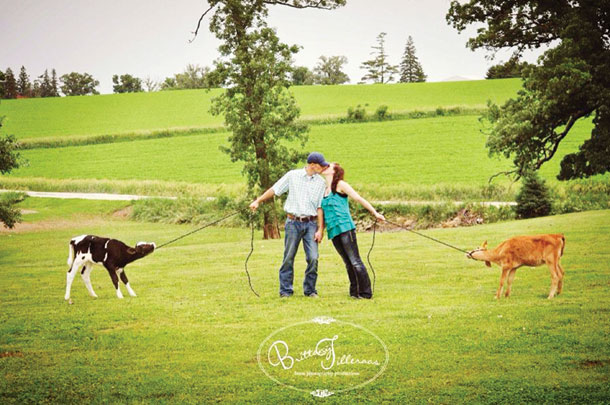
5. Laurelbrook Farm raises calves to produce 100-pound average
Published: April 1, 2015 e-newsletter and May 25, 2015 print issue
Summary: Calves gaining 2.2 pounds per day and first-lactation heifers producing more than 100 pounds of milk per day – who wouldn’t want that? At Laurelbrook Farm in East Canaan, Connecticut, that is exactly what herd manager and part-owner Cricket Jacquier is seeing in his calves and replacement heifers. 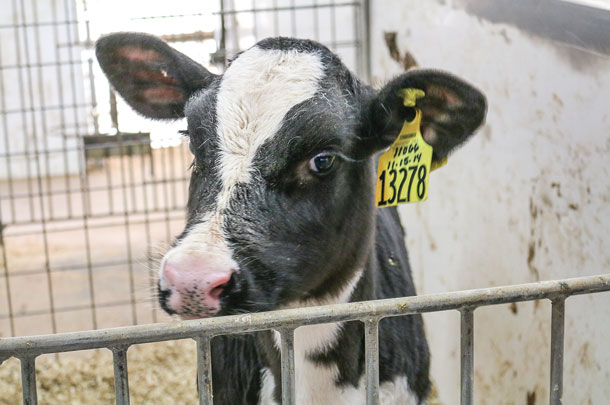
Good management and nutrition are two important components to reaching these numbers, especially since post-weaning, the heifers spend most of their time on four different satellite farms. Pre-weaning, calves receive 2 quarts of milk replacer three times per day. This started a few years ago when Jacquier noticed that the winter calves, who received three feedings per day, far outperformed the calves from any other time of the year and decided to feed three times per day 365 days a year.
6. Learning to linger: Robot update
Published: April 25, 2015 e-newsletter
Summary: While we typically see robotic technology articles perform well, we were somewhat surprised to see this guest blog so high on the list. Virginia dairy producer Laura Flory opened up about what a typical day is like on her farm since they installed robotic milkers.
We think your column resonated with readers because you so eloquently described what it’s like to have such a change in the farming lifestyle when switching to robotic milking. What’s the most common question you hear from those interested in robots, specific to those lifestyle changes, and how do you typically respond?
One of the questions I hear most frequently after moving into the robot barn is, “What do you do with all your free time?” The first few times I was asked, I stuttered through a response, not really knowing what to say, quite frankly, because I didn’t feel like I had a lot of this so-called “free time.” But the more I was asked, the more I thought about it, and I finally figured out how I want to answer that question.
You see, to me, a robot dairy is a lot like a high-performance race car. Sure, it’s shiny and speedy, but that car has to have a team of sharp mechanics, a good set of tires and someone in the driver’s seat to perform at optimum level. Sure, you can put it on cruise for a while, but if there’s no one in the driver’s seat, or if the driver stops watching where he or she is going, that race car will crash, and it won’t be slowly.
Yes, the robots milk the cows, and they can help you identify problems quickly and with astounding accuracy, but they can’t navigate the curves and know when to slow down or speed up. And they cannot replace a human being who knows what an animal needs. So I use most of that “free time” trying to keep it between the lines, but the greatest part of it all is that now I can use my time on my terms, not the hands of the clock.

—Laura Flory, dairy producer, Hillside Farm
Click here to read the full article.
7. Shiloh Dairy: Where calves are a priority
Published: Jan. 6, 2015 e-newsletter
Summary: Having good replacement heifers is essential to running a successful dairy. At Shiloh Dairy in Brillion, Wisconsin, Cathy Speirs, who owns the dairy with her husband, Gordon, makes sure their calves receive all the tools they need to succeed.
Calf care starts when the calf is born. Within minutes, the calf is dried off and its navel is dipped. This kind of attention pervades the Speirses’ entire heifer-raising program as they move through each stage of the process.
To help them excel even in the cold, the calves stay in an open-air barn for the first two weeks before moving to outdoor calf hutches. Ten days after weaning, the calves move to the calf barn, where they are housed in groups. As they grow, the smaller groups join together until the calves are 6 or 7 months old and they move to a 300-head freestall barn. 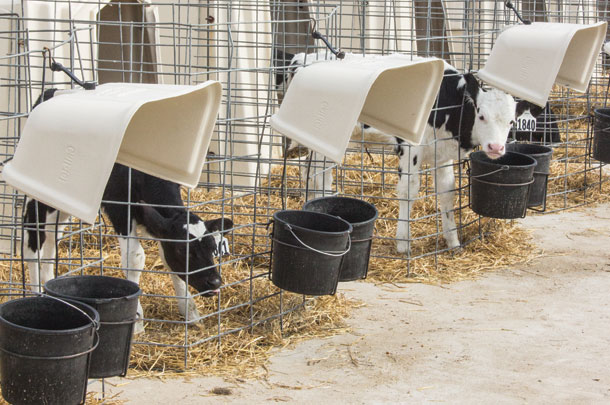
What advice do you have for producers who are considering building a calf barn?
The most critical point to consider with housing calves indoors is ventilation. And for us, moving calves indoors after they have been raised outdoors has added an extra challenge. We always have been mindful not to overpopulate. The group pens are 14 feet by 40 feet including feed alley, and we put no more than eight calves per pen.
In order to provide fresh air, we have a modified tunnel ventilation system comprised of 16 fans on the west-end wall. They are on an automatic control system, which turns them on and off based on barn temperature. We supply air for the fans by opening doors and curtains at the east end of the barn as necessary. The final component is a plastic ventilation tube. It is professionally engineered to allow for air exchange without causing a draft on the backs of the calves. The calves are fed a ration balanced to provide the energy levels necessary to grow and to stay healthy.
—Cathy Speirs, dairy producer, Shiloh Dairy
Click here to read the full article.
8. How to identify, treat and prevent seven fresh cow illnesses
Published: Feb. 6, 2015 e-newsletter and May 25, 2015 print issue
Summary: Progressive Dairyman Editor Karen Lee wrote up this handy article from a presentation by Animart’s Dr. Vicky Lauer. She described the symptoms, treatment, prevention and repercussions for seven fresh cow illnesses – milk fever, uterine prolapse, retained placenta, metritis, mastitis, ketosis and displaced abomasum.
Of these seven fresh cow illnesses, which one do you think is still most often misdiagnosed by veterinarians? Which one by dairy producers?
In my personal opinion, subclinical milk fever is the most commonly misdiagnosed or under-recognized condition by both veterinarians and producers. Most of the other diseases are either visible to the naked eye or are easy to test for with a ketone meter or the California Mastitis Test.
Unfortunately, there are few economical cow-side tests for subclinical milk fever. Thus, you have to take a blood sample to a lab or medical facility, which increases the time and expense involved. Many people just don’t take that extra step. However, preventing subclinical milk fever will decrease the incidence of other fresh cow diseases, so a rapid, economical cow-side test would be extremely beneficial.
—Dr. Vicky Lauer, Professional Services Veterinarian, Animart
9. Bigger fans, dry cow cooling help dairy beat Florida heat
Published: July 19, 2015 print issue
Summary: Florida dairy cows experience the double-whammy of heat stress – high temperatures and extreme humidity. During the peak heat stress months of July through September, one can expect to exceed a heat index of 95ºF on 78 of those days. This makes cooling 6,000 cows a key part of management at Alliance Dairy in Trenton, Florida. Fans and sprinklers provide relief for both lactating and dry cows. Owner Jan Henderson updates Progressive Dairyman on how they handled the heat in 2015. 
What level of heat stress did you experience in 2015? Have you made further modifications to your heat abatement plan?
This year’s heat stress was typical, but the duration was longer than normal. Our only change this year to deal with the heat was scraping our dry cow barns earlier in the morning when it was “cooler.” We were scraping in the afternoon and herding the cows up to one side of the barn and causing unnecessary stress in the heat of the day. Since scraping in the morning, we have had fewer cows freshening early and less transition problems after freshening.
—Jan Henderson, dairy producer, Alliance Dairy
10. After success with sand in freestalls, Georgia dairyman adds it to calf hutches
Published: July 13, 2015 Extra
Summary: We’ve all heard of dairymen using sand in their freestalls. But after seeing how well it worked in his freestalls, Calvin Moody, owner of Brooksco Dairy in Quitman, Georgia, put it in his calf pens as well. This change, when combined with a shade cloth, helps keep calves cool in the hot Georgia sun. 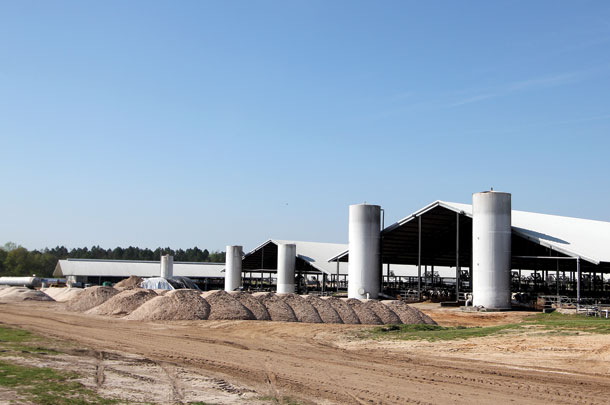
Moody also has two other dairies, Jeffco and Westbrook; however, the calves and heifers are raised at Brooksco Dairy. Close attention to animal comfort, cleanliness and performance keeps these three operations running smoothly.
Click here to read the full article.
11. Never walk a breeding pen again?
Published: Feb. 13, 2015 Extra
Summary: For dairyman Steve Bollant of Stitzer, Wisconsin, rumination monitoring technology has changed the way he manages reproduction on his dairy. Instead of spending his days walking breeding pens and watching for heats, he relies on the system to identify cows that need to be bred. Bollant also finds this tool helps him to better manage fresh cows. Rumination activity tips off nutrition problems early, which has led to a dramatic reduction in displaced abomasums (DAs) and increased milk production.
How are you incorporating the data from rumination and activity monitors into your herd health and reproduction management?
Steve Bollant continues to incorporate the data from his rumination and activity monitoring system into his everyday herd management. Particularly, he now has a program that includes milk weights so that he can better monitor cows during their first 14 days in milk. With the goal of hitting 90 to 100 pounds of milk or more by seven to eight days fresh, catching fresh cows that are off-feed early is critical.
As far as his breeding program, does Bollant miss the days of walking pens to check for heats? “No,” he affirms. “This is working well; I would not go back to the old method.”
He still uses OvSynch on the cows that need it but changed the protocol last summer by adding in a second shot of lutalyse.
—Progressive Dairyman Editor Peggy Coffeen
Click hereto read the full article.
12. Cool stuff we saw at World Ag Expo 2015
Published: Feb. 25, 2015 e-newsletter and March 12, 2015 print issue
Summary: It’s become a tradition for our team of editors to provide a list of “Cool things we saw” at World Ag Expo and World Dairy Expo. Among the editors’ highlights from 2015 were NFL players signing autographs, Top O’ the Morn Farms’ milk bar and a number of new, unique products. Watch for a similar recap following the 2016 World Ag Expo. 
13. The real value of manure
Published: Jan. 23, 2015 e-newsletter and Feb. 25, 2015 print issue
Summary: Last fall, Dr. Brad Joern, professor of agronomy from Purdue University, presented on the value of manure at the 2014 World Dairy Expo in Madison, Wisconsin. He outlined four factors that help to determine manure’s value: nutrient content, application rate, losses between application and crop uptake and where manure is applied.
Improper application can reduce the value of manure and even cause field damage. This can occur with the use of inadequate nutrient availability algorithms used to develop nutrient management plans. These algorithms do not always account for time of application, the difference between total nitrogen and ammonium nitrogen and how soil types and climates vary by region instead of state boundaries.
Joern has created a software model that looks at soil moisture (rainfall) and soil temperature along with the farmer’s location, soil texture, soil pH and fertilizer protocol. Preliminary testing of the model has been successful, and now different crops, soil conditions and climate are being tested.
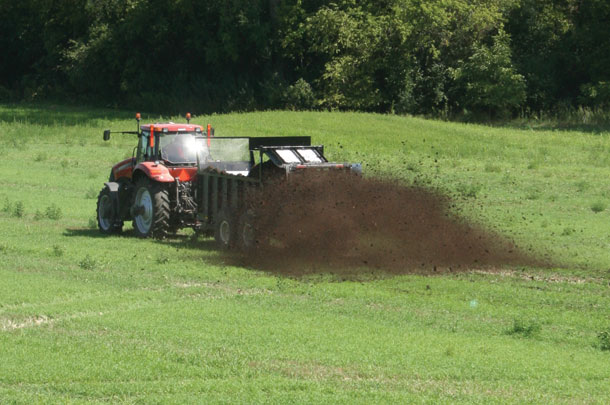
Provide an update on the testing phase of your new software model.
We have been quite busy testing our models and giving presentations about how we would like to see crop, soil, topography, weather and other data be combined to help farmers make more informed and accurate decisions regarding the management of inputs that directly affect their profitability at the subfield scale.
As a direct result of the positive feedback and encouragement for this approach to making informed decisions, we have decided to license our software, including our soil moisture/irrigation scheduling and in-season nitrogen management tools as well as our land-grant university fertilizer recommendations and nitrogen and phosphorus risk assessment tools.
We plan to license these products to farmer cooperatives, agricultural retailer networks, independent crop consultants and other members of our agriculture community to help farmers take advantage of the latest advances in science to make more informed nutrient input and management decisions. For more information about these tools, call (765) 427-2898 or reach out by email.
—Dr. Brad Joern, professor of agronomy from Purdue University
14. Vermont farm eliminates boss cow bullying at feedbunk
Published: May 28, 2015 e-newsletter
Summary: When L&L Farms Inc. in Morrisville, Vermont, built a new barn in 2014, the freestalls were not the only place they put in dividers. Short loops line the feed rail in lieu of headlocks. The purpose behind this concept was that cutting down on competition at the bunk would reduce stress and provide greater cow comfort. While the up-front cost was higher, the dairy says for the cows it was worth it, noting that the “boss cow” factor is removed. 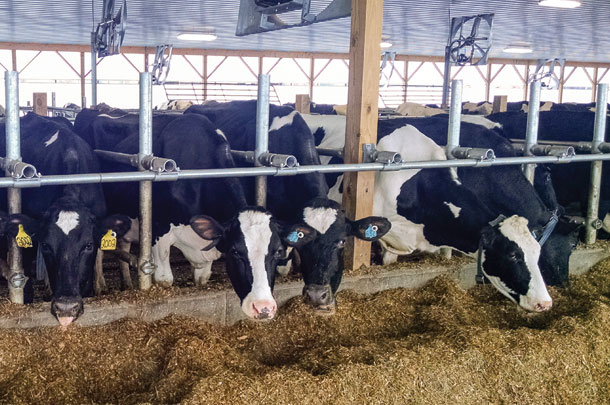
In what scenarios would the feedbunk dividers provide a solution over headlocks?
I could make the case that cows would benefit in any scenario in having feedbunk dividers over headlocks, as the dividers reduce stress in the feed line. Whether it is in the parlor, the holding area, the stall or the feedbunk, the more we can do to take stress out of the cow’s life, the healthier and more productive she will be.
When in barns with dividers at the feedbunk, I observed calm cows not worrying about their neighbors, not feeling rushed and not being able to bully or be bullied. A cow could stand at the bunk for as long as she felt hungry. In a headlock bunk, every time a cow backs up to raise her head higher than the lock, she is at risk for pushing and being bullied out of position. Once out of position, she may stop eating before she has had her fill. I recommend observing cows in a divider feedbunk barn. After seeing the effect, you might be as convinced as I am of the stress-reducing effects.
—Dean Throndsen, Advanced Comfort Technology, Inc.
Click hereto read the full article.
15. How to troubleshoot low milk fat yields
Published: April 20, 2015 e-newsletter
Summary: In this article, Dr. Adam Lock from Michigan State University and Dr. Tom Jenkins from Clemson University discuss the nutritional regulation of milk components. Milkfat depression is caused by changes in the dietary lipid (a combination of fatty acids and glycerol) as it passes through the rumen. Micro-organisms in the rumen attack the unsaturated fatty acids and remove the double bonds, converting them to saturated fat for the intestine.
Ideally, within this process, linoleic acid is converted to cis-9, trans-11 conjugated linoleic acid (CLA). A change in the rumen environment could cause this transition to go in another direction, resulting in trans-10, cis-12 CLA, which is the compound that causes milkfat depression, Jenkins said.
Feeding too much unsaturated fat is one of the known causes for this CLA shift. One way producers and nutritionists can account for the risk of unsaturated fatty acids in the ration is by looking at the rumen unsaturated fatty acid load, or RUFAL.
How could a dairy producer or nutritionist find the RUFAL calculation of a ration?
RUFAL is calculated by adding up daily intakes of three unsaturated fatty acids, oleic acid (C18:1), linoleic acid (C18:2) and linolenic acid (C18:3). I express the result as a percentage of the TMR dry matter. You can obtain the intakes of these three fatty acids from most nutrition modeling programs, but they are only estimates based on library values. Actual RUFAL values are obtained by having a TMR sample analyzed by a commercial feed analysis lab for individual fatty acids; then just simply determine C18:1 + C18:2 + C18:3 when each is expressed as a percentage of the TMR dry matter.
—Dr. Tom Jenkins from Clemson University
16. Can supplemental fats increase milk yield and components?
Published: July 31, 2015 e-newsletter
Dr. Adam Lock, associate professor, Michigan State University, summarizes the article and answers the question:
How can you tell if fat supplementation is helping or hurting your herd?
The addition of supplemental fatty acids to diets is a common practice in dairy nutrition to increase dietary energy density and to support milk production. Although, in general, fatty acid supplementation has been shown to increase milk yield, milkfat yield and the efficiency of milk production, great variation has been reported in production performance for different fatty acid supplements – and, indeed, the same supplement across different diets and studies. Further work is required to characterize the sources of variation in response to fatty acid supplementation. 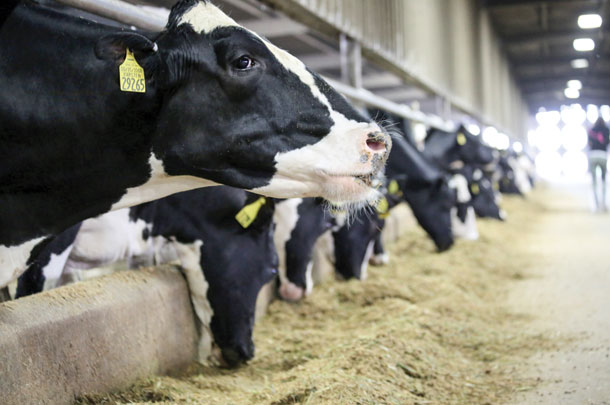
Just as we recognize that not all protein sources are the same, it is important to remember that not all fatty acid supplements are the same. The key is to know what fatty acids are present in the supplement, particularly fatty acid chain length and their degree of unsaturation.
Once this information is known, it is important to consider the possible effects of these fatty acids on dry matter intake, rumen metabolism, small intestine digestibility, milk component synthesis in the mammary gland, energy partitioning between the mammary gland and other tissues, and body condition. Interactions with other dietary components and the level of milk production are also important in determining the response to various fatty acid supplements. The extent of these simultaneous changes along with the goal of the nutritional strategy employed will ultimately determine the overall effect of the supplemental fatty acids and the associated decision regarding their inclusion in diets for lactating dairy cows.
—Dr. Adam Lock, Michigan State University
17. Planning for success one calf at a time at Ruedinger Farms Inc.
Published: Jan. 19, 2015 print issue
Summary: To be successful, you must first plan to be successful. At Ruedinger Farms Inc. in Van Dyne, Wisconsin, they have done just that, especially in their calf program.
Farm manager Kevin Kaiser has strict calf care protocols in place to ensure each calf receives the care it needs from the very beginning. Now that they are done growing the dairy from 1,000 to 1,400 head, they are using genomic testing in their culling decisions. This helps them eliminate the bottom third of their animals and push their top third to great genetic potential. 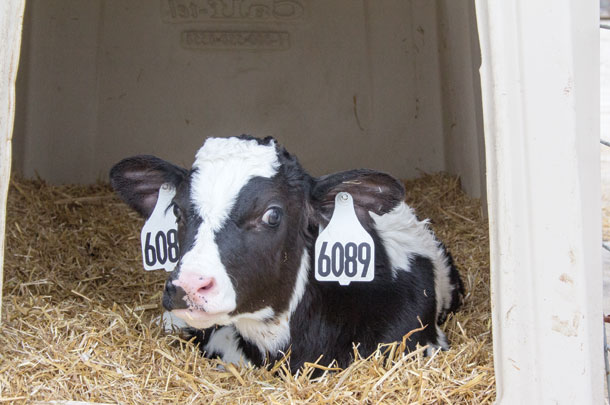
What has changed on Ruedinger Farms since the article ran?
Overall, our calf-raising program continued to click along very well since the article was written.
In spring 2014, we started to lose some calves that typically were getting through their normal challenges. Nothing had changed in our protocols or the staff administering them. It started out minor, and in fall 2014, we had still only had one calf that posted with rotavirus. I immediately discussed this with our veterinarian and told him that we have never had a calf post with rotavirus.
As months progressed, the problem became more severe until we had had several calves posted where rotavirus was the only pathogen found. As we continued to lose calves to rotavirus, I knew something had changed. I continued to impress the severity of this change with our veterinarian. At his suggestion, we had him do a complete sanitation assessment. The ATP meter revealed nothing significant anywhere in our system. Per recommendation, we started sanitizing with a chlorine dioxide product, but this didn’t seem to reduce the issue.
We began to question the effectiveness of the scour-guard vaccine that we were using. Were we getting any immune response to the rotavirus component in this product? Had our rotavirus mutated or was there a strain or sub-type in our environment at such levels that our calves had no ability to handle this challenge?
Our vet believed this was likely the case. He further investigated this possibility with a staff doctor at Newport Labs. It all seemed to make sense as we gathered more information and started to put this puzzle together.
We had the virus typed to see how similar or dissimilar it is to our vaccine and discovered that our rotavirus strain is only 88 percent similar to the commercial vaccine. Newport Labs told us you have to be 95 percent similar or better for a vaccine to work. We are now pursuing getting a custom vaccine made.
In the meantime, we are managing this challenge as best as we can. Our vet does weekly total proteins on the calves. If the calves’ total proteins are in the 6 to 7 and above range, they are much more likely to get through the rotavirus challenges. However, to consistently have proteins in the 6 to 7 range, we have added a second colostrum feeding of 2 quarts approximately four to six hours after the first feeding of 1 gallon. Even with our pasteurized colostrum testing 24 to 28 on the Brix refractometer, 1 gallon doesn’t seem to be enough. With this additional colostrum feeding, we are always hand-to-mouth on our supply and colostrum replacer is on hand for when the supply is short.
— Kevin Kaiser, Farm Manager, Ruedinger Farms Inc.
18. Producer panel shares feedback on rumination monitoring technology
Published: March 13, 2015 Extra
Summary: Two Pennsylvania dairymen, Clint Burkholder of Burk-Lea Farms and Bill Lesher of Way-Har Farms, and one heifer raiser, Lane Sollenberger of Dream Farms, all agree that heat detection and/or rumination monitors have changed the way they manage reproduction and, ultimately, led to measurable improvements in their programs. Burkholder has bumped his pregnancy rate up by 10 percent while Lesher credits his rumination monitoring system with cutting his shot program costs in half. Using heat detection monitors, Sollenberger has noted less reliance on synchronization programs and a 9 percent increase in pregnancy rate while reducing average age at conception by 10 days. 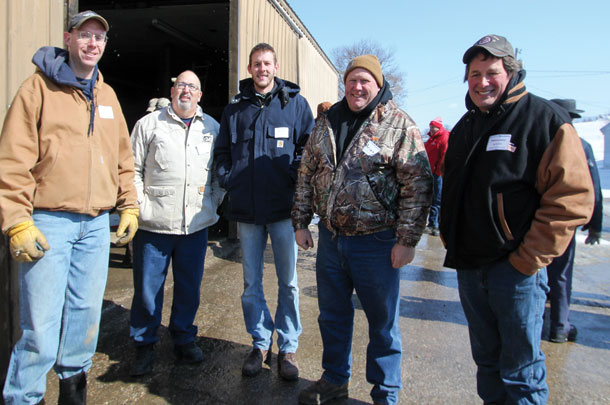
We asked Sollenberger:
How has rumination monitoring technology continued to change the way you manage Dream Farms?
We know without question now that what was before a four-person crew is now 2.75, so we have eliminated the labor need for 1.25 employees. We have also been able to reduce predicted age at first calving by a full month (to 22 months) since going on this system. We do a first pregnancy check at about 30 to 36 days with ultrasound. We used to run an 80 percent pregnancy rate, but now we are running 93 to 95 percent, which means that we are now catching animals that were open a lot sooner and getting them bred back sooner.
We put the collars on heifers at approximately three to four weeks ahead of their scheduled breeding so as they go through a heat cycle, we can then start to see a baseline for normal activity for each heifer; then when she comes into heat, we can see how much it has spiked. You can help yourself by working off of the baseline before actually inseminating. It’s been one more of many tools in our toolbox that are needed to be successful in heifer raising.
—Lane Sollenberger, Dream Farms manager and president of the Dairy Calf and Heifer Association
Click here to read the full article.
19. 3 ways to improve newborn hygiene
Published: May 25, 2015 print issue
Summary: Infections can enter a newborn calf’s body through the mouth, nose and navel, making newborn hygiene essential to raising healthy calves. This means that the equipment being used to feed or care for the calf needs to be clean. The best way to do this is to keep equipment handy, have strict cleaning protocols in place and, where applicable, use disposable items.
Since infections can enter a calf orally, colostrum hygiene is essential. To achieve this, follow these three steps:
1. Do not introduce new bacteria into the colostrum.
2. Do not allow existing bacteria to grow.
3. If you know you have a bacterial problem, pasteurize.
Following these steps will help your calves get off to the right start.
What is the most common misconception you see in regards to newborn hygiene?
Assuming that your tools are clean enough. Hygiene is the most important building block to raising a healthy replacement animal and we all need to treat it with respect.
Wash all calf feeding equipment as if it was part of the milk line, replace your nipples, tube feeders or any hoses frequently. Get proper brushes to reach difficult areas and break up the biofilm.
After a cleaning, remember to store things properly. Often, I see tube feeders, nipple feeders or bottles left sitting in the sink without regard to the risk of people washing their hands over them or rinsing off equipment. Store your calf feeding tools out of the way in a clean and dry area.
Good managers know that measuring effectiveness of protocols is the key to success. Get an ATP or a Pro-clean swab and test your calf feeding equipment for protein residues; you will quickly know whether your protocols are working and where you need to improve.
—Andy Beckel, Calf Consultant, Golden Calf Company
20. California dairy turns manure into renewable diesel
Published: May 18, 2015 e-newsletter
Summary: In April this year, Scott Brothers Dairy, a 1,100-cow operation in California, became the first livestock facility in the world to produce no-sulfur renewable diesel products from manure. The farm teamed up with Ag Waste Solutions, which designed the manure processing system. In addition to diesel, the process produces a refined wax product whose market value is three times that of the diesel.
21. Calf nutrition: 4 growth targets for optimum production
Published: April 1, 2015 e-newsletter
Summary: Studies show that calf nutrition plays a big role in lactation performance as adults. Calves that receive good nutrition should hit these four targets:
• Target 1: Double their weight
• Target 2: Focus on average daily gain
• Target 3: Maintain growth after weaning
• Target 4: Enter the milking herd
In your article, you mentioned feeding a calf grower feed post-weaning to help calves transition to a higher-forage diet. What are some key components producers should look for when selecting a calf grower?
The calf health and growth results that dairymen are seeing with full-potential feeding pre-weaning have led to a review of post-weaning nutrition and feeding practices. A grower should be part of a three-step process in feeding calves – milk diet, calf starter and grower. A 22 percent calf starter should be fed through 12 weeks old. Follow with grower from 13 weeks through 6 months old free-choice up to 10 pounds per head per day. The calf grower should be 18 percent crude protein to make sure that the protein-to-energy ratio in the diet results in proper frame growth.
The ingredients in the grower should be similar to the calf starter to ensure a smooth transition from starter to grower. Include grain sources that will result in volatile fatty acid production to promote rumen development. The calf grower can be either texturized or pelleted, but avoid fines. Include an ionophore.
—Gary Geisler, calf and heifer specialist, Purina Animal Nutrition
22. Names in the News: Sue McCloskey
Published: Feb. 7, 2015 print issue
Summary: When Select Milk Producers, the milk cooperative behind Fair Oaks Farm in Indiana, first teamed up with Coca-Cola to create Fairlife, there was a lot of misinformation. Some dubbed the ultra-filtration process as “franken-milk.” It garnered so much attention that NPR approached the farm about participating in an interview about the new product. Sue McCloskey, co-owner, said the most difficult interview question was: “Why not just milk cows?” She said she had to stop and think about how to best respond and said something to the effect of, “If you can dream it, you can do it. And if you don’t do it, somebody else will.”

23. Keeping calves cool: Tips for hutch management in the summer
Published: July 22, 2015 print issue
Summary: Author Brian Wesemann says proper housing is a key component in keeping your calves cool and comfortable during warmer weather. Opaque polyethylene calf hutches are preferred because they completely block the sun’s rays and tend to stay cooler than other calf hutch options.
Good calf hutches should be well ventilated and spaced out to allow for unrestricted airflow between them. Giving calves a cool interior in environment encourages them to stay inside during the hottest parts of the day.
Although opaque hutches tend to be cooler, heat stress-related problems can develop quickly, and calves should be monitored closely during these periods regardless of their hutch environment. 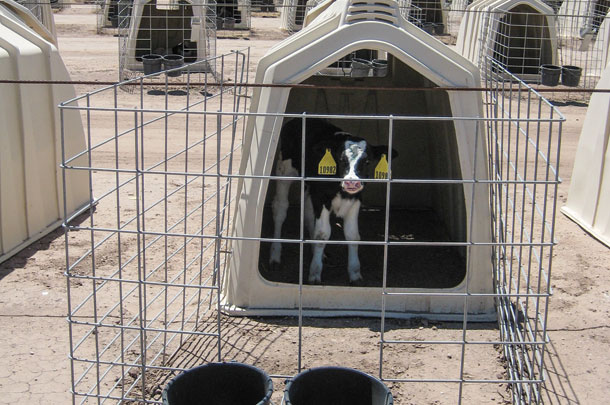
What are some tips for hutch management in the winter?
Plan and prepare
- Where are the things you need every day in relation to the calves? Is there a more practical and beneficial place for them to be on the coldest day of the year for your area? It is easier to relocate things on days other than the coldest of the year.
The three D’s: dry, draft-free and deep
- Keep calves dry, your gear dry and your travel areas dry. Working with calves and liquid feeds is challenging. Having standard operating procedures for the cold can help stop doorways and aisles from becoming slippery or icy.
- As the cold sets in, you can check to see where the drafty leaks are and find ways to stop them before it is too late.
- Deep bedding with longer particle length provides the nesting space a calf needs to capture warm air close to its body.
—Brian Wesemann, Director of Sales, Calf-Tel Hampel Animal Care
24. Opportunities for savings with less silage shrink
Published: April 20, 2015 e-newsletter
Summary: You had it – and then you lost it. Getting silage from the field and into the cow without losing it is one of the most challenging tasks and expensive losses on a dairy. It’s like poking a hole in the money bag that you’re carrying to the bank. Although some loss is unavoidable, we have three opportunities to prevent it and save money – at silo fill, during fermentation and at feedout. 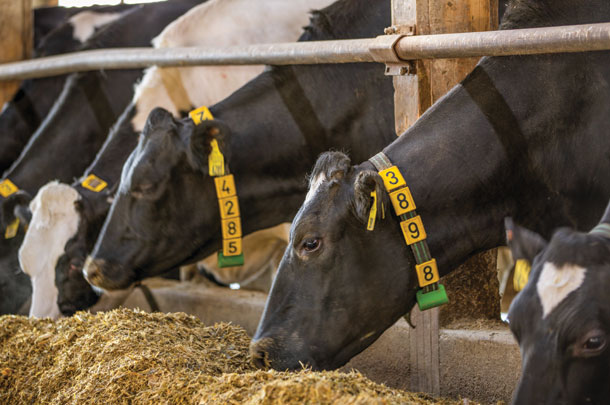
You mentioned that there are three primary phases of silage storage resulting in shrink – fill shrinkage, fermentation shrinkage and feedout shrinkage. From what you’ve seen in the field, if a dairy crops manager was to focus on improving just one of those phases with the silage employee team, does one phase stand out to you more than the others as generally needing the most improvement?
Although all three phases have obvious economic and practical importance, and all three phases frequently show opportunity for improvement, fill shrinkage most often represents the area with potential to make the greatest positive impact. Fill shrinkage is where you have considerable management control via proper harvest moisture, packing density, correct shape/dimensions of storage structure and proper covering. With so many facets of silo filling, there are multiple opportunities for not only success but also failure at managing fill-related shrink. Furthermore, making fill shrinkage the first priority is logical because filling practices also have significant influence on fermentation and feedout shrinkage.
Once fill management is in proper perspective, the use of combination forage additives containing both homofermentative strains (Lactobacillus plantarum or Enterococcus faecium) and Lactobacillus buchneri strains is the most effective management approach to reduce fermentation and feedout shrinkage along with proper face management (e.g., use of mechanical facers).
— Dann Bolinger, DuPont Pioneer dairy specialist
25. Collection of rumen fluid
Published: Feb. 6, 2015 e-newsletter
Summary: It’s been said that the difference between God and a veterinarian is: God knows he’s not a veterinarian. (We’ll wait while you think about that one. Hopefully, veterinarians reading this have a sense of humor.) Nonetheless, rumen transfaunation from a fistulated cow to a sick recipient cow is pretty darn impressive on the list of things science has been able to accomplish to boost rumen health. Although it has become a routine procedure in the animal health world, the process for collection is still worth review.
Rumen transfaunation using fistulated cows has been around several decades now, and it seems to be one of the areas for treating indigestion or maintaining and improving rumen function that hasn’t changed much during that time. Are other methods being developed or is the process
being refined in the near future?

There is a tendency to use oral fluid products that are commercially available to treat simple indigestion of animals on a dairy farm. These commercial products might contain combinations of probiotics, calcium propionate and potassium chloride, for example. The commercial products are convenient to use. These commercial products might also be cheaper than having a fistulated cow on the dairy.
We often have a rumen-fistulated cow that is lactating, so the cow is in the milk string and managed just like any other milk cow. Because the fistulated cow is lactating, she is paying her way with milk sales. For us, rumen fluid has many advantages over commercial products – live micro-organisms and wide array of fermentative chemical compounds that cannot be duplicated by commercial products. The rumen-fistulated cows are managed just like the other animals, so there is nothing special for management. The rumen-fistulated cows work well in our dairy management system for herd health as well as supporting teaching, research and outreach needs. PD
—Ed DePeters, Department of Animal Science, University of California – Davis


